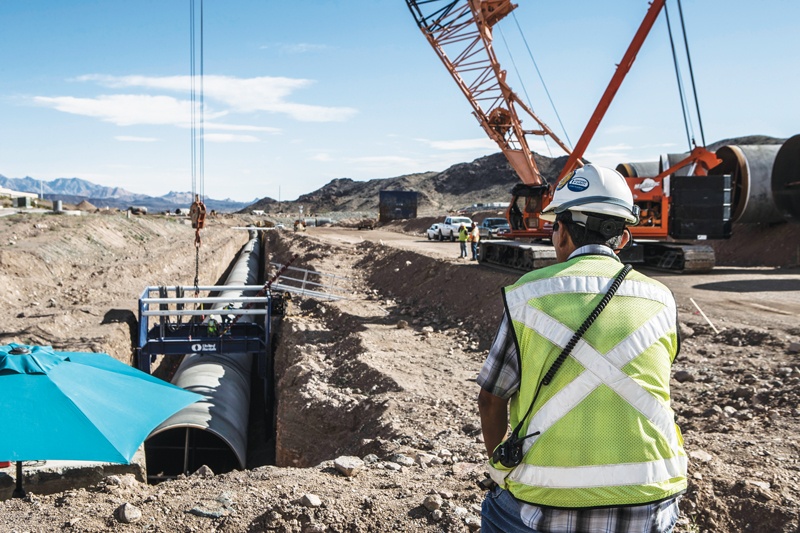Access management tools, fences, lights and other solutions set the stage for safer day-to-day operations.
When a worker is injured on a jobsite, the repercussions can extend beyond their pain and suffering. For example, safety investigations may slow or halt construction activity, impacting the project schedule and budget. Insurance premiums may rise due to claims filed, and the company’s reputation may suffer.
Safety measures such as designating a competent person and enforcing the proper use of appropriate PPE, including fall protection equipment, are essential. But contractors can also take basic steps to provide a safer jobsite with the help of rental solutions that range from ignition keypads to light towers to ground protection mats.
The six rental solutions below are worth considering on most jobsites.
1. Equipment access management
Heavy equipment is essential on construction sites, but it also poses safety risks. Unsecured loads can injure workers, as can equipment roll-overs and struck-by and caught in/between incidents. That’s why restricting the use of equipment to properly trained and certified operators is so important.
Ignition keypad locks are an effective solution when authorized users are issued a unique PIN code. RFID technology offers a more advanced solution.
An RFID reader can be added to the keypad so that if workers have been issued an RFID-enabled ID badge, they can tap it to access the equipment. This approach provides accurate real-time and historical data on equipment usage, which boosts accountability. Companies can assign rights and privileges in worker profiles via a cloud-based worksite management platform.

2. Temporary fencing
There are good reasons to prevent unauthorized people from entering jobsites. Trespassers can distract workers, get injured and damage or steal tools or equipment. Temporary fencing keeps them out and establishes a well-defined jobsite perimeter.
- Anti-climb temporary fence panels are fast to install and easy to relocate. Base weights, sandbags or fence stabilizer assemblies can be used to provide extra stability.
- Chain link fences with cement footings are budget-friendly choices for longer projects.
- Driven-post chain link fences are the most stable and durable, but also most difficult to move.
Contractors can deploy temporary fences or barriers to separate active work areas from walkways and to clearly delineate routes for vehicle and equipment movement.
When fencing is used to create a jobsite perimeter, modular smart turnstiles seamlessly integrate with entry points to provide automated site access management. Entrants tap a company-issued ID badge or fob to unlock the turnstile barrier and create a record of site entry. These turnstiles can also be used to manage access to hazardous or sensitive areas.
3. Ground protection mats
Ground protection mats installed around the jobsite at the beginning of a project allow work to continue after rain or snowmelt turns the site muddy. They also increase safety by leveling and stabilizing ground traveled by equipment and vehicles so tires don’t sink into the ground and equipment doesn’t tilt. By preventing ruts in the earth left by dried mud, they reduce tripping hazards, too.
Crane mats and other heavy-duty mats used to create equipment work pads stabilize cranes, diggers, boom lifts and other heavy equipment during operation, reducing the risk of a potentially catastrophic tip-over.

Explore Rental Solutions on United Rentals' Online Marketplace
4. Portable and towable lighting solutions
Workers are safer and deliver higher-quality craftsmanship when they can clearly see what they’re doing. In low-light conditions, contractors can illuminate work areas as well as pathways and stairwells with portable work lights, including LED light stands. For more coverage and brighter light, they can opt for a towable light tower.
Adequate lighting inside storage containers also boosts safety. Containers with built-in solar-powered lighting feature an overhead light strip that allows crews to retrieve what they need without fumbling around in the dark.
5. Heating and cooling solutions
In extreme temperatures, productivity drops while safety hazards increase. Crews working in hot weather face a risk of heat exhaustion and heat stroke. Jobsite cooling solutions such as spot coolers, portable evaporative coolers and Vector coolers provide relief from the worst of the heat.
Temporary heaters provide warmth when the mercury dips into frostbite territory. A temporary equipment partner can help companies choose the right heater based on where the work is taking place and the ventilation available. Direct fired heaters are ideal for outdoor construction sites, for example. The equipment partner can also size the heater for the application.
On large jobsites, temporary free span fabric structures provide a cooled or heated break room and lunchroom. These shelters can be installed rapidly and reconfigured as necessary to meet changing jobsite demands.
6. Trench protective systems
Excavations are among the most dangerous areas on a construction jobsite. Knowing when a trench protective system is required and choosing an appropriate system is the best way to prevent a trench collapse, most of which are fatal to workers in the trench.
Factors such as the depth of the excavation, the soil type, adjacent structures and surface encumbrances dictate the type of system needed. Systems include sloping, benching, shoring and shielding. Some excavations, such as those that exceed the depth rating stipulated in the manufacturer’s tabulated data, require a custom-engineered solution. An equipment rental provider with expertise in trench safety solutions and in-house engineers can provide solutions that comply with OSHA (or, in Canada, OHS) trench safety regulations.
Safety training and PPE are essential to any construction activity, but when the jobsite itself is safer, workers have an even better chance of going home without injury every night. Contractors can work with a trusted, full-service rental equipment provider such as United Rentals to identify rental solutions that will enhance safety on each project and jobsite.
To make your next jobsite safer, explore the rentals solution on our online marketplace or contact your local United Rentals branch for personal assistance.



